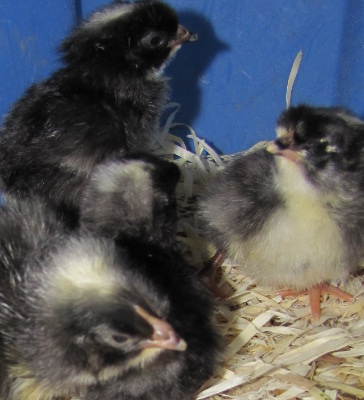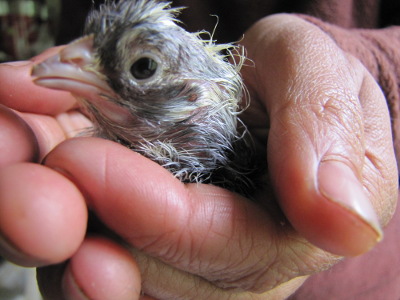
Day 21 hatch rate
 All of the books and websites
agree that you get your best chicks by the end of day 21, so even
though I'll let the rest of the eggs sit in the incubator for another
day or two, I want to do my hatching analysis with just the chicks
hatched by Tuesday afternoon. At that time, there were five happy
chicks snuggled under the brooder, two aided and ailing chicks
in the first aid incubator (more on them tomorrow), one chick just
hatched in the big incubator, and two pipped eggs.
All of the books and websites
agree that you get your best chicks by the end of day 21, so even
though I'll let the rest of the eggs sit in the incubator for another
day or two, I want to do my hatching analysis with just the chicks
hatched by Tuesday afternoon. At that time, there were five happy
chicks snuggled under the brooder, two aided and ailing chicks
in the first aid incubator (more on them tomorrow), one chick just
hatched in the big incubator, and two pipped eggs.
Of the six chicks that
hatched on their own, five were Cuckoo Marans and only one was a
homegrown egg. Keep in mind that the Cuckoo Marans were jiggled
around by the post office and had to wait a whole week from laying
before going in the incubator, a combination of factors that often
reduces hatch rates. So why did they do so much better?
 Nine of the 24 eggs I started
with were from our four year old hens because I was hoping to pass on
their foraging genes, but I've since read that any hen older than two
years is going to produce eggs with limited viability. Even the
eggs from our "young" Golden Comet are a bit suspect since she's three
years old. Of these geriatric eggs, one hatched unaided just at
the end of day 21, I helped one out, and one is a late pipper.
For the sake of comparison, our mail order Cuckoo Marans self-hatched
42% of their eggs by the end of day 21, I helped one chick out of the
shell, and one more is a late pipper. Clearly, age of the hen
matters.
Nine of the 24 eggs I started
with were from our four year old hens because I was hoping to pass on
their foraging genes, but I've since read that any hen older than two
years is going to produce eggs with limited viability. Even the
eggs from our "young" Golden Comet are a bit suspect since she's three
years old. Of these geriatric eggs, one hatched unaided just at
the end of day 21, I helped one out, and one is a late pipper.
For the sake of comparison, our mail order Cuckoo Marans self-hatched
42% of their eggs by the end of day 21, I helped one chick out of the
shell, and one more is a late pipper. Clearly, age of the hen
matters.
As a side note, next
time I'll be sure to plan my hatch for the weekend. My ability to
focus on work while chicks are struggling out of their shells over my
right shoulder is pretty much nill. Good thing my boss is nice!
Want more in-depth information? Browse through our books.
Or explore more posts by date or by subject.
About us: Anna Hess and Mark Hamilton spent over a decade living self-sufficiently in the mountains of Virginia before moving north to start over from scratch in the foothills of Ohio. They've experimented with permaculture, no-till gardening, trailersteading, home-based microbusinesses and much more, writing about their adventures in both blogs and books.
Want to be notified when new comments are posted on this page? Click on the RSS button after you add a comment to subscribe to the comment feed, or simply check the box beside "email replies to me" while writing your comment.
- Remove comment
- Remove comment
- Remove comment
- Remove comment
- Remove comment
